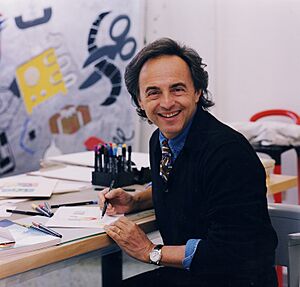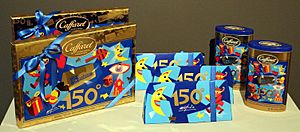Ugo Nespolo facts for kids
Quick facts for kids
Ugo Nespolo
|
|
|---|---|
 |
|
| Born | 29 August 1941 Mosso, Biella, Italy
|
| Nationality | Italian |
| Education | Accademia Albertina di Belle Arti, Turin |
| Known for | Painting, Sculpture |
Ugo Nespolo (born on August 29, 1941, in Mosso, Biella, Italy) is a famous Italian artist. He is known for his work as a painter, sculptor, filmmaker, and writer. Today, he lives and works in Turin, Italy.
Contents
About Ugo Nespolo
Ugo Nespolo studied art at the Accademia Albertina di Belle Arti in Turin. He also earned a degree in Modern Literature from the University of Turin.
His journey as an artist began in the 1960s. His art was inspired by exciting new styles like Pop Art. Pop Art used images from popular culture, like advertisements and comic books. He was also influenced by conceptual art, which focuses on ideas, and Arte Povera, which uses simple, everyday materials. Nespolo got to see these art movements up close during a trip to the United States in 1967. He visited the U.S. often, especially in the 1980s. A big part of Nespolo's art is using humor and being a bit rebellious.
Since 2010, he has been part of the "Immagine & Poesia" group. This is an art and literature group in Turin that promotes creativity.
Nespolo's Films
In the mid-1960s, Nespolo started making experimental films. These films often explored new ways of telling stories or showing ideas. His first film, Grazie, mamma Kodak, came out in 1966. Many of his artist friends, like Lucio Fontana and Enrico Baj, appeared in his movies.
One of his films, A.G. (1968), shows a visit by the poet Allen Ginsberg to Turin. In 2001, he directed Film/a/TO. Nespolo's films have been shown in famous places like the Beaubourg in Paris and the Philadelphia Museum of Modern Art. Over 40 years, Nespolo has made and directed about twenty films.
Art in Everyday Life

In the 1980s, Nespolo started creating art for everyday objects. He made beautiful ceramics and blown glass items. He also designed more than fifty posters for art shows and other events. He even created advertising campaigns for well-known brands like Campari.
In 2002, Nespolo was chosen to help design the Metropolitana di Torino (Turin's subway system). His goal was to create the first "underground museum of modern art." You can see his glass etchings and images decorating several subway stations.
Art for the Stage
In 1986, Nespolo had the chance to design the stage sets for an opera called Turandot. This was in Stamford, Connecticut. After that, he designed sets and costumes for many other theatre shows. These included Don Chisciotte in Rome in 1990 and L'elisir d'amore for operas in Rome, Paris, and other cities in 1995. In 2007, he designed the stage and costumes for Puccini's famous opera Madama Butterfly.
Palio and Traditions
Nespolo is also known for his work on Palios. A Palio is a traditional Italian contest or race, often with a special banner or flag designed for the winner. In 1998, he designed the Palio for the Giostra della Quintana in Ascoli Piceno. He also created designs for the Palio di Asti in 2000 and for the Giostra della Quintana in Foligno in 1991 and 2009.
One of his most famous Palio designs was the Palio (also called the Drappellone or banner) for the Palio dell'Assunta in Siena in August 2007.
Art Exhibitions
Ugo Nespolo's art has been shown in many important exhibitions around the world. Here are some of the places where his work has been displayed:
- Palazzo Reale Arengario, Milan, 1990
- International Biennale of Ceramics and Antiques, Faenza Exhibition Center, 1990
- International Ceramics Festival, Shigaraki Ceramic World, Japan, 1991
- Borghi and Co. Gallery, New York, 1992
- Palazzo della Permanenente, Milan, 1995
- Romanian Ministry of Culture, Bucharest, 1995
- Promotrice delle Belle Arti, Turin, 1996
- National Museum of Fine Arts in Valletta, Malta, 1997
- Museo Nacional de Bellas Artes, Buenos Aires, 1997
- Centro de Arte Contemporaneo de Cordoba, Córdoba, 1997
- Museo Municipal de Arte Moderno de Mendoza, Mendoza, 1997
- Museo Nacional de Artes Visuales, Montevideo, 1997
- Palazzo Reale, Naples, 2000
- Centre Pompidou, Paris, 2001
- Fukui, Japan, 2001
- Villa dei Laghi, Venaria Reale (Turin), 2002
- Modern Art Gallery, Moscow, 2003
- St. Petersburg, 2003
- Minsk, 2003
- Modern Art Gallery Riga, Latvia, 2003
- Istituto Italiano di Cultura, Paris, 2003
- International Film Festival of Locarno, Switzerland, 2003
- Chinese National Museum of Peking, 2003
- Ciurlionis National Museum of Art, Vilnius, Lithuania, 2004
- Guang Dong Museum of Art of Guangzhou, Canton, China, 2004
- Moscow Museum of Modern Art, Moscow, 2004
- Fine Arts Russian Academy, St. Petersburg, 2004
- Poldi Pezzoli Museum, Milan, 2005
- Hong Kong Cultural Centre, Hong Kong, 2005
- Museo Nazionale del Cinema of Turin, 2005
- Museo del Cinema of Turin, 2008
- Palazzo Grassi, Venice, 2008
- 48th Ceramics Exhibition of Castellamonte, 2008
- Nespolo. Ritorno a casa. Un percorso antologico, Biella, Italy, 2009
Filmography
Here is a list of films Nespolo has been involved with:
| Year | Title | Note |
|---|---|---|
| 1966 | Grazie, mamma Kodak | |
| 1967 | Le gote in fiamme | |
| Neonmerzare | ||
| La galante avventura del cavaliere dal lieto volto | ||
| 1968 | Tucci-ucci | |
| A.G. | ||
| Boettinbianchenero | ||
| Buongiorno, Michelangelo | ||
| 1973 | Con-certo rituale | |
| 1975 | Un supermaschio | |
| 1976 | Andare a Roma | |
| 1978 | Il faticoso tempo della sicurezza (Lo spaccone) | |
| 1982 | Le porte girevoli | |
| 1984 | Fontane a Torino ovvero: alla ricerca dello zampillo perduto | as actor; director: Luciana Ros |
| 1994 | Time after time | |
| 2001 | Film/a/TO | exhibited at Turin, berceau du cinéma italien, Centre Pompidou, Paris |
| 2005 | Italiana | |
| Ativa. Un ritratto | ||
| Glance. As far as the eye can see | ||
| Dentro e fuori. Angelo Pezzana. Un ritratto | ||
| 2006 | La metro a Torino | |
| 2007 | Superglance | |
| Stefania Belmondo "Più veloce dell’aquila" | ||
| Peopling The Palaces at Venaria Reale | as actor; director: Peter Greenaway | |
| Superglance |

